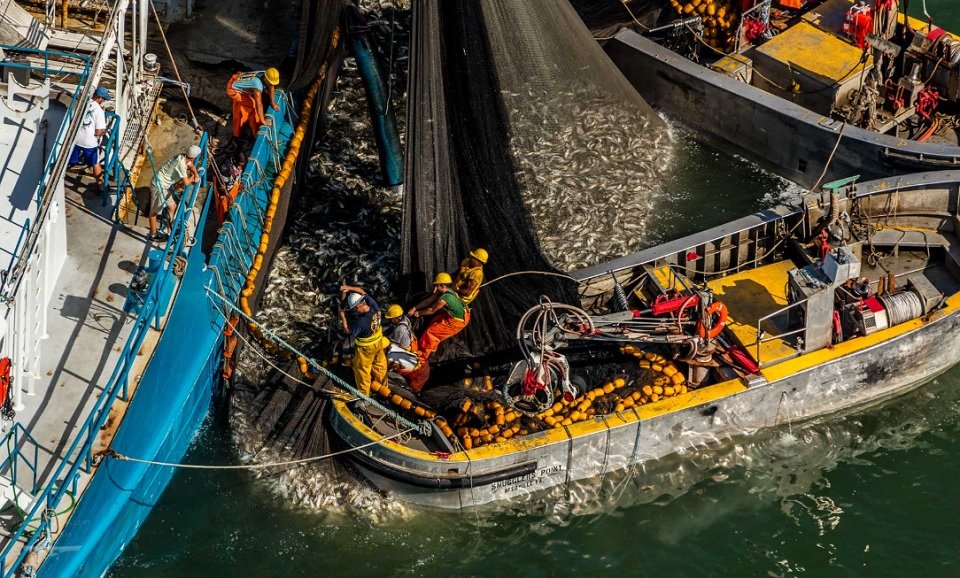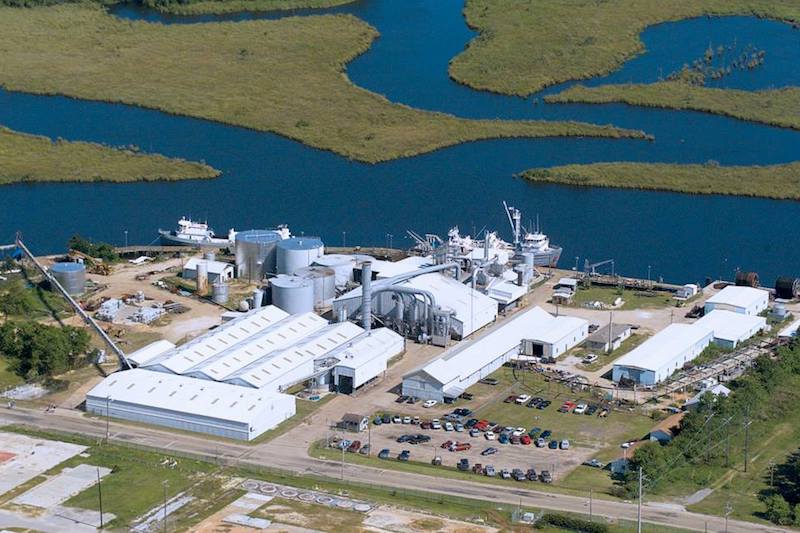
Hey, you’re exceeding your limit. No, no, check out our math. You see, 4 is really 2.56743.
Making Sense of Menhaden
In the Chesapeake Bay, a fight is raging over a little fish with an outsized importance.
Over the past decade and a half, the Atlantic striped bass population has declined by nearly 50 percent, according to the US National Oceanic and Atmospheric Administration. By the 1970s, they were nearly fished into oblivion but were steadily rebounding until they weren’t. Recreational anglers and local commercial outfits are pointing fingers at Omega Protein, the harvester of roughly 90 percent of the menhaden pulled from US waters. They have been fishing menhaden for reduction in various capacities and under various names since 1918 but officially formed as Omega Protein in the late 1990s.

Jack Darrell is an independent journalist specializing in fisheries, Indigenous affairs, and the environment. His work appears in Earth Island Journal, SlackWater, and Greater, Greater Washington. Born on the Chesapeake Bay and being similar to a crab, he is not able to stay away from the water for long.
By Jack Darrell / Hakai Magazine / February 6, 2023
Over the week of July 4, 2022, people flocking to Chesapeake Bay’s Virginia coast were met at the water’s edge by hordes of ghastly visitors: schools of hand-sized silver menhaden washed up by the thousands, their carcasses floating in the surf in the summer’s heat. By the week’s end, as the fish liquefied in a dumpster at a nearby wharf, circulating petitions were gaining signatures.
“End the most destructive fishery in the USA! The Menhaden Reduction Industry!”
Conservationists garnered almost 20,000 signatures in the first month, and the outcry made it to the desk of Virginia governor Glenn Youngkin.
The dead menhaden were the victims of a net spill, says Chris Macaluso. In fact, it was one of three last summer. Macaluso is director of the Center for Marine Fisheries at the Theodore Roosevelt Conservation Partnership, whose organization circulated one of the myriad petitions.
Macaluso says that in one of last summer’s net spills, spotter planes called in a school of menhaden but failed to see a school of federally protected red drum swimming below. When the fishers cinched the net shut and pulled it from the depths, it held enough red drum to give a game warden a coronary. They rushed to open the net to free them, flooding the bay with thousands of kilograms of floundering, dying fish.
If you’re a fish, says Macaluso, you usually don’t survive a run-in with a purse seine net
“Even fish that they would intend to return back to the water, because they legally can’t bring them in the boat, those fish are dead, too. And that’s just the reality of how they fish.”
Net spills—whether from an intentional release or a tear in the net—dump mostly dead fish back into the sea. The whims of wind and tide carry the carcasses to shore.
The death of so many menhaden is alarming. At the bottom of the food chain, this fatty little fish is key to maintaining the ecosystem—menhaden feed seabirds and big predatory fish. Net spills are a waste, but more frustrating to locals is why the menhaden were netted in such huge numbers in the first place: for reduction into fish meal and fish oil.
The petitions represent the latest skirmish in a decades-long battle between recreational anglers and Omega Protein, a Canadian fishing company. The anglers don’t fish for menhaden, they’re hooking one of the big predatory fish that feed on the little fish—striped bass.
The Chesapeake Bay estuary is the nursery for 70 to 90 percent of the entire Atlantic stock of striped bass
To understand this big battle over a tiny fish, you must first understand striped bass. Atlantic striped bass, also known as rockfish, can live for more than 30 years in the wild and balloon up to the size of a 12-year-old child. They are a high-value catch for anglers from the St. Lawrence River to the Gulf of Mexico. The Chesapeake Bay is especially vital: the estuary is the nursery for 70 to 90 percent of the entire Atlantic stock.
Over the past decade and a half, the Atlantic striped bass population has declined by nearly 50 percent, according to the US National Oceanic and Atmospheric Administration. By the 1970s, they were nearly fished into oblivion but were steadily rebounding until they weren’t. Recreational anglers and local commercial outfits are pointing fingers at Omega Protein, the harvester of roughly 90 percent of the menhaden pulled from US waters. They have been fishing menhaden for reduction in various capacities and under various names since 1918 but officially formed as Omega Protein in the late 1990s.

Over the past decade and a half, the Atlantic striped bass population has declined by nearly 50 percent, according to the US National Oceanic and Atmospheric Administration.
For recreational anglers like Andrew Braker, a filmmaker and sport fisherman who grew up on the Chesapeake, the situation is symbolic of what he describes as a pervasive form of ecological myopia in applied fisheries management. To buoy the striped bass population, government regulations restrict the striped bass catch. “That’s great,” says Braker. “But what do those stripers eat? And how is that being managed?”
Against this backdrop, menhaden management has become a flashpoint in the overarching fight over striped bass. Yet experts seem unsure what to do with the little fish.
The nonprofit Chesapeake Bay Foundation, a watchdog organization, wants the menhaden harvest of more than 51,000 tonnes annually within the bay to stop, or at least move farther out to sea. A pause would give regulators time to better understand how the catch is affecting the bay’s fish stocks and water quality.
Are you kidding me!
Late last year, however, the Atlantic States Marine Fisheries Commission (ASMFC), the organization tasked with regulating the fishery, went the other way. The ASMFC argues menhaden are not overfished and raised the menhaden fishery quota for the entire region by 20 percent to 233,000 tonnes, though the harvest cap in the bay remains at 51,000.
Historically, fisheries managers have considered each species in isolation. Despite the decision that raised the menhaden quota, the ASMFC is working to change this, and the organization based its increased quota on its efforts to develop a more holistic ecosystem management approach that accounts for the projected populations of species further up the food chain. For instance, ecosystem modeling may target a menhaden fishing rate that carves out enough of the population to ideally sustain the minimum striped bass population. But that’s an incredibly difficult calculation—especially when fish are frequently moving in and out of the estuary.
Ben Landry, Omega Protein’s director of public affairs, chalks the opposition to the increased menhaden quota up to distrust of science. “My belief is that [recreational anglers] opposed to menhaden fishing simply refuse to trust the best available science on the population,” Landry says by email.
He says many of the same conservationists who are now pushing back previously championed the ASMFC’s model. “Now that the model indicates that the quota can be increased with little to no risk of overharvesting, it doesn’t fit their narrative,” he says.
In a written statement, the American Saltwater Guides Association disagrees. “Are we going against science? No, we are incredibly hesitant to approve an unprecedented increase in the [total allowable catch] for the most important forage fish in the ocean with some shaky data years and would have preferred to see a more gradual increase.”
Genevieve Nesslage, an expert in fisheries stock assessments and population dynamics at the Chesapeake Biological Laboratory in Maryland, emphasizes the challenge of calculating the interactions between menhaden and striped bass.
You can incorporate striped bass into the menhaden stock equation, Nesslage says, but the more species you tie in, the more precarious the juggling act becomes—especially against a backdrop of climate change, which is putting inordinate pressure on marine life. Nesslage’s research group is working on an alternative modeling approach, but she says neither her model nor the one used by ASMFC is a full-blown ecosystem model.

Hey, we love puppies, so, of course, we wouldn’t overfish again this year.
Mike Waine, the Atlantic fisheries policy director for the American Sportfishing Association, the industry trade group for recreational fishing, agrees the ASMFC’s model is an improvement over the single-species management of yesteryear but adds that coastwide it is still looking at too large of an area to capture the bay’s complicated dynamics.
Recreational fishing is big business, Waine says. “To us, the value of a little menhaden is to feed the predator species that we like to go out and fish for. That’s our value proposition for this ecologically important public resource. Obviously, some of the other stakeholders have a different one. And that’s really where the dynamics play out as everyone tries to advocate for their position.”
While those positions play out across the tables of inland boardrooms, petitions will continue to circulate and mechanical winches will strain with the weight of nets full of menhaden that will make it to shore one way or another.
NOTE: Featured Image – Omega Protein expands its fleet.


